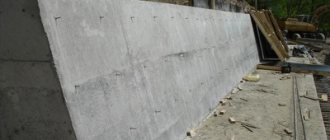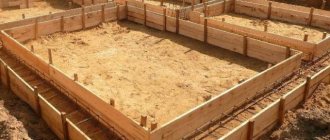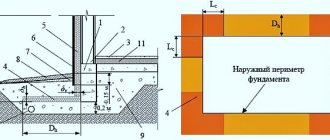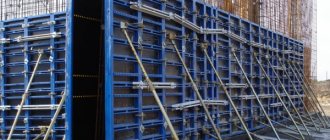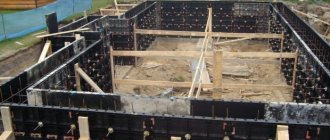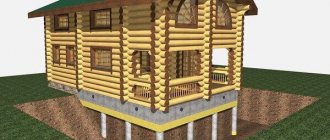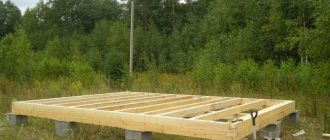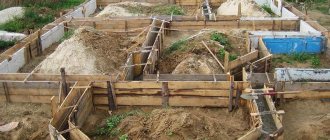A concrete base is the best and most popular option.
Let us consider in detail the types of greenhouse foundations made of concrete, their many advantages and possible disadvantages, as well as step-by-step installation with your own hands.
Foundation for a greenhouse - choosing a design
What is a greenhouse and why is it needed? We think there is no point in answering this question if you are looking for information on how to make a foundation for a greenhouse. This suggests that you have already made a decision about construction and know why you need it. For our part, we will be happy to help you when choosing the best foundation option for a greenhouse. We’ll also tell you how to make a foundation for a greenhouse with your own hands, step by step. Thank you for trusting and using our site. It's nice to be useful to people
The greenhouse must be of high quality and the harvest must be rich
So, usually a greenhouse is made of lightweight materials that allow sunlight to pass through. This allows you to grow fresh vegetables and herbs all year round. But a greenhouse is a massive building. Therefore, it must be built according to all the rules of the construction craft. This means that such a structure requires a reliable and solid foundation. The foundation, as in any other building, will evenly distribute the load. Like any building, the choice of foundation for a greenhouse depends on the conditions on your site. It matters what kind of soil you have, and the level of groundwater is also an important indicator. Another important value is the level of soil freezing. This indicator is different for each region. Therefore, it is necessary to take all this into account when building a foundation not only for houses and fences, but also for a greenhouse.
Limits of soil freezing in the Russian Federation
Choosing a fertile place
It is very important to choose the right location for the greenhouse. The area should be flat, not shaded, and there should be no buildings or large trees at a distance of 3 meters. Trees not only create shade, their root system will interfere with the development of plants in the greenhouse, and nearby buildings contribute to the appearance of drafts. The greenhouse must be oriented to the cardinal points. The correct location would be from east to west in length, then one wide side will always face south, and this will provide the greatest amount of sunlight.
Another advantage of a mobile greenhouse is that if you choose the wrong location, it’s only for one year; next year you won’t repeat the same mistake.
Why do you need a foundation for a greenhouse?
Let's take a closer look at why a foundation for a greenhouse is needed. And is it possible to build a greenhouse without a foundation and will such a greenhouse be reliable and durable? The foundation under the greenhouse acts as a supporting structure. This design is aimed at giving the structure reliability, strength and safety. And most importantly, you need to build in such a way that the structure is durable and serves you for as long as possible. It is important to understand that you are building a greenhouse in order to get a good harvest. And the presence of a foundation of various types gives the plant a lot. It has a positive effect, plants are more protected from moisture, small rodents and insects, which can have a detrimental effect on plants. And they can prevent you from enjoying a big harvest.
Of course, there are ways to build a greenhouse without a foundation, but this is a completely different level of construction. Let's look again at all the advantages of a foundation under a greenhouse. In addition to the fact that the foundation affects the structure, making it stronger, more stable, reliable, safe and durable, it can also help to avoid the following problems.
The foundation will solve problems
- We all know that the building has windage. This is especially true for large greenhouses that are made of lightweight materials, for example, polycarbonate or polyethylene film. With strong gusts of wind, such buildings may move or collapse. The foundation for a greenhouse allows you to avoid any displacement, since the frame of the greenhouse is attached to the base, namely the foundation frame.
- Rapid heat loss due to poor thermal insulation. If a greenhouse is built on a foundation, it will rise 20-30 cm above the ground. And such a rise, although not significant at first glance, plays an important role. And most importantly, it allows you to save up to 15% of heat. Which is very important for plants, especially in cool weather.
- Rapid destruction process and therefore short service life. When you build a greenhouse on a foundation, this design allows the frame material to not come into contact with the ground. Most often this is wood, so contact with the ground causes moisture to be absorbed by the wood. And this leads to the appearance of rot and subsequent destruction. Therefore, the foundation significantly improves the working conditions of the material and extends its service life significantly.
Greenhouse without a foundation?
We describe the benefits of a greenhouse foundation so carefully that you may get the impression that absolutely any greenhouse needs a foundation. But it is not so. Of course, for a high-quality greenhouse, a foundation in the form of a load-bearing base is really necessary, but it is not always used for small structures. For example, for greenhouses and small greenhouses made from plastic pipes, it is simply not practical to use a foundation. It is usually easier to dismantle such structures in the fall and hide them for storage until the next season comes. And you will put it back together without much effort, time and money.
For such a greenhouse a foundation is required
So it turns out that the foundation needs to be built only for those greenhouses that are large in size and planned for a permanent period (stationary greenhouses). A foundation for greenhouses made of polycarbonate or using old window frames is simply necessary. These greenhouses are large and last all year round. This means that without a reliable load-bearing foundation, the supporting frame of such greenhouses without a foundation can simply collapse, which can knock down or even destroy such a building. A particular threat to all buildings, and especially to those without a foundation, is the period when the snow begins to melt. During this period, the soil is very mobile and unstable. It is oversaturated with moisture and can have a detrimental effect on buildings.
Types of greenhouse foundations
The foundation for greenhouses of various designs is practically no different from the load-bearing foundations that are used for the construction of low-rise residential buildings, small-sized residential buildings, technical premises, etc. The main difference between the foundation for a greenhouse is that its depth is much higher than the level of soil freezing.
Greenhouses come in various designs, and for most of these greenhouses, the foundation is not much different from those foundations that are used in the construction of low-rise residential buildings, small outbuildings and residential premises. Of course, there is a main difference between the foundation for a greenhouse. It lies in the fact that usually the foundation lies much higher than the freezing point of the soil in a given region.
Point foundation for a greenhouse
For example. If we look at the map of soil freezing (which was there before), we can notice that the depth of soil freezing for the Northwestern part of Russia is approximately 100-160 cm. Under such conditions, the foundation for the greenhouse is laid to a depth of approximately 80 cm. This also applies for small greenhouses for growing flowers and herbs, and for fairly large buildings, and polycarbonate greenhouses.
Choosing a foundation for a greenhouse
Next, let's look at what types of foundations are used in the construction of greenhouses. The choice of the type of base for greenhouses depends on the conditions in which you are going to build your greenhouse. How correctly you make a decision in favor of one or another type of foundation for a greenhouse depends on its further performance and the benefits it will bring you. Here is a list of the main types of greenhouse foundations.
Columnar foundation for a greenhouse
Columnar foundation . We talked in detail about this type of foundation when we discussed building a foundation for a fence, so if you wish, you can also study this material. So, this type of foundation for a greenhouse is affordable and easy to implement. Essentially, these are supports made of concrete (can also be made of brick), which are immersed in the ground evenly over the area of the entire greenhouse. In such a design, it is important to observe proper distribution of supports over the area of the entire structure. The supports are located at a certain pitch. This distance is calculated depending on the weight of the structure and its dimensions.
Columnar foundation for a greenhouse
Pile foundation for a greenhouse
Pile foundation . It is considered a strong and durable method of constructing foundations not only for greenhouses and outbuildings, but is also used in the construction of residential buildings. This method is very similar to the previous, columnar option. Only in contrast to this, in the process of constructing a pile foundation for a greenhouse, I use screw piles. We talked to you in detail about all the pros and cons of screw piles and pile foundations in the last article. Therefore, before choosing this type of base, be sure to read this material.
Scheme for using screw piles
Strip foundation for a greenhouse
Strip foundation. This type of foundation is the most popular, although it itself has its own disadvantages and features during construction. The strip foundation for a house and a greenhouse is a continuous line of concrete that is located along the entire perimeter of the structure. There are two types of strip foundation for a greenhouse. The first option is that the foundation is level with the ground. The second is when the foundation partially protrudes above the ground surface and forms the basement part. When insulating such a foundation, foam plastic or extruded polystyrene foam is usually used. Let us make a reservation once again that this is not the only method; it has its own difficulties and disadvantages, so take into account all the conditions before choosing a strip foundation for a greenhouse.
Strip foundation for a greenhouse
Slab foundation for greenhouse
Slab foundation . A very, very reliable and solid foundation. The slab foundation for a greenhouse, as for other buildings, is a slab located under the entire area of the structure. It has its own construction features. Before starting construction, it is necessary to calculate in detail the thickness of the slab and select the appropriate grade of concrete. A slab foundation for a greenhouse, like a strip foundation, can be partially or completely immersed in the ground.
Slab foundation for greenhouse
Materials for the foundation for a greenhouse
As we have already said, the foundation for a greenhouse and the materials used in its construction are not much different from the construction of a foundation for a residential building or other buildings. Just the scale of construction is a little smaller. Usually during construction they use concrete mixture, bricks, crushed stone, wooden beams, reinforcement, steel poles, foam blocks and some other materials that may be needed depending on the construction conditions and type of structure.
When constructing strip or point types of foundations for a greenhouse, they can use either one material or a combination of materials used. For example, they build a columnar foundation using reinforced concrete, and to construct a grillage they use a wooden beam that is suitable in cross-section and size. But when building a strip foundation for a greenhouse, the frame is often made from thick edged boards or timber.
Greenhouse where a slab foundation is possible
But slab foundations are used extremely rarely in the construction of greenhouses. This is due not only to the fact that this type of foundation is very expensive and difficult to implement. As we have already said, a greenhouse is needed in order to bring a rich harvest, but the slab foundation blocks access to fertile soil layers, which makes it impossible to use it in the construction of greenhouses. An exception is a greenhouse for flowers and other plants that are planted in pots. Then each plant has its own soil. Only in this case can you install a slab base under the greenhouse.
What type of foundation to choose for a greenhouse
It has been noted that, according to statistics, one of the most popular types of foundation for a greenhouse is a strip foundation. But any competent builder will tell you that for such a construction, a strip foundation does not always justify itself and is not always simply rational. This is most often due to the fact that all areas have different soil characteristics. And even areas in the same dacha farm may have different levels of groundwater. And based on these conditions, you need to choose the type of foundation. Therefore, an important criterion when choosing a foundation is the type of soil and the depth of groundwater.
What you need to know to choose
Here are some facts to consider when choosing a greenhouse foundation. They will help you make balanced and thoughtful choices.
What and how to choose?
Paragraph 1
When the groundwater is quite low, a shallow strip foundation for a greenhouse is perfect. In this case, the soil should not be prone to heaving and consist mostly of sand and gravel; thanks to this composition, it will filter and absorb a sufficient volume of water that comes with precipitation. In the case where clay predominates in the area where it is planned to build a greenhouse, then a sand and gravel cushion cannot be avoided. Soil is of key importance when choosing construction technologies. Therefore, if possible, especially when building a residential building, be sure to do geotechnical surveys of the soil.
Point 2
When a site has a high level of groundwater and a lot of moisture, then in such cases a columnar and pile type of foundation for a greenhouse is installed using a wooden grillage. If geotechnical surveys have not yet been carried out, then determining the amount of moisture is not so difficult. To do this, you need to observe how quickly the puddles disappear after the rain. You can also do a test, dig a hole and see how quickly water accumulates in it. If puddles persist for a long time after rain, and water quickly appears in the hole, then such soil is oversaturated with moisture. Point types of foundation are also excellent for heaving soils, especially if you plan to build a large structure. For example, if you are interested in a 10 by 3 m greenhouse, 2 m high on clay soil, then the choice of base is obvious.
Point 3
A slab or monolithic foundation for a greenhouse is chosen if it is planned to build on very unstable types of soil. These soils are: clay, loam, peat, sandy loam and some others. Choosing this type of base for a greenhouse will allow you to suppress heaving, which will act unevenly, as well as soil mobility, while preserving the integrity of the greenhouse skin and the entire structure. But again, we repeat that this type of base is chosen extremely rarely, because the slab limits access to fertile soil. Therefore, if you plan to grow flowers in pots, then this choice may be justified.
Foundation for a greenhouse, price
The foundation for a greenhouse, the price of which will be minimal , is a columnar base made of concrete, with a wooden grillage. Of course, if necessary, you can replace the concrete mixture and use cobblestones or bricks. But you must understand that this will only increase the cost of such a building. In addition to this, brick is more difficult to use and work with than concrete. But this, as they say, is not an acquired taste.
But if you choose the best foundation for a greenhouse in terms of price and quality ratio , then the best option is a strip concrete foundation or a block strip. It will solve most of the problems and will be a reliable basis, while the price will be reasonable. But when building medium and small greenhouses, concrete or concrete blocks can be replaced with wooden beams. But be sure to treat it with bitumen varnish or mastic.
A slab monolithic foundation is the most expensive and labor-intensive option, but also the most reliable. When pouring a slab foundation for a greenhouse, a large amount of not only concrete mixture, but also reinforcement is used, which makes its price very high. You also need to take into account the time spent on construction. If you urgently need a greenhouse for your dacha, then this type of foundation is unlikely to suit you. This is due to the fact that the foundation will dry completely approximately 28 days after pouring.
This is what a slab foundation looks like for a house
What to do with the soil
When choosing a location, you need to examine the soil. To do this, it is recommended to dig a special hole with dimensions of 70 cm by 70 cm and a depth of 1 meter 20 cm. Now you need to determine the type of soil. This is easy to do if you take a handful of it and try to make a ball. It was possible to roll a ball or sausage - there was a lot of clay, but it didn’t work out - sandy soil. Sand is a very good basis for greenhouse soil: it allows water to pass through, and excess water will prevent the roots from rotting. If the soil is clayey, it will have to be replaced.
To replace the soil under the greenhouse, you need to dig a pit at least 70 cm deep and fill it with 40 centimeters of sand, leaving the top 30 cm to be filled with a fertile mixture. In addition, it would be good to know the depth of the groundwater. If they are found higher in the pit, you will have to make drainage grooves to drain excess water.
Polycarbonate greenhouse foundation
What is a polycarbonate greenhouse? This is a building that represents the following design. Galvanized pipes 20 by 20 or 25 by 25 mm are used as a frame, but polycarbonate sheets are used as a covering material. This material actually gives the greenhouse its name. Typically, such greenhouses are made in a factory and delivered ready-assembled or disassembled. But many people make polycarbonate greenhouses with their own hands, which is possible if desired. In the design and construction of a polycarbonate greenhouse, it is important to choose the right type of foundation. The choice of foundation depends on the soil; we have already considered some features of the choice depending on the type of soil. Also important when choosing is the total weight of the structure and its dimensions.
Polycarbonate strip base for a greenhouse
For polycarbonate greenhouses, an excellent solution when choosing a foundation would be to choose a strip foundation made of concrete. Such a foundation will provide good stability to the structure. And also it will not have a high price. But to insulate such a foundation, as we wrote earlier, polystyrene foam is used. This is done as shown in the picture.
I recommend building large greenhouses over 10 m on a strip foundation with insulation. Especially if you plan to artificially heat the soil so that you can use the greenhouse all year round.
Insulation for a strip foundation for a polystyrene foam greenhouse
Calculation of weight and dimensions for a polycarbonate greenhouse
Let's try to calculate some dimensions and weight of the greenhouse. For example, let’s take an ordinary, one might say standard, polycarbonate greenhouse. The greenhouse manufacturer does not matter now, so we will omit this information for now. We will further calculate: a frame without polycarbonate sheets for a greenhouse measuring 6 by 3 m will be approximately 67-69 kg. The greenhouse, measuring 8 by 3 m, has a supporting structure weight of about 75 kg. The approximate weight of all polycarbonate sheets that we will use for cladding, even taking into account the error and a certain margin, should not exceed 20 kg.
So it turns out that knowing this data, we can draw the following conclusion. In order to build a polycarbonate greenhouse on an average typical summer cottage, the following types of foundations can be used during construction: columnar, strip or block foundations will be optimal. If you, as the owner, have a large supply of funds and the price of the foundation for the greenhouse is not very important, then it is possible, and would be a good solution, to build a greenhouse on a pile foundation, using the special screw piles that we talked about earlier.
If you are very limited in funds and want to save as much as possible, then it would be an excellent solution to use a shallow belt made of wooden beams as a foundation when building a greenhouse. Which before this must have been treated with an antiseptic or hydrophobic composition.
We will tell you in more detail and in more detail about how to make a strip foundation for a polycarbonate greenhouse with your own hands a little further.
Frame mounting methods
Regardless of the type of foundation, several types of fastening greenhouses to the edges of supporting structures are used. The fastening scheme depends on the purpose of the building - temporary or permanent. Due to the need for seasonal dismantling of temporary greenhouses, dismountable fastening units should be provided. Watch the video on how to properly attach polycarbonate for a greenhouse.
Classification of dismountable fasteners:
- Anchor bolts with threaded elements embedded in the harness;
- Locks, latches and fastenings of the “latch” type – fasteners for small removable greenhouses, based on the principle of a bolt mechanism;
- Grooves in the foundation into which frame posts are inserted, secured with studs or bolts;
- Pins driven into the ground - hollow frame elements are strung on them.
When installing a greenhouse on open ground, driving brackets are used. With a certain step, metal pins are inserted into the mounting loops, driven into the ground to a depth of half a meter.
Fixed greenhouses are permanently attached to the foundation, and waterproofing of the piping is required. When constructing concrete foundation supports, the frame elements are cast in place even at the stage of pouring the concrete mixture. The use of embedded parts allows you to create welded joints, which also need to be treated with a hydrophobic compound. The possibility of installing a non-dismountable greenhouse using collapsible units cannot be ruled out.
Foundation for a greenhouse made of timber
Greenhouses with a wooden frame made of timber or edged boards are rarely made in large sizes. In this regard, the foundation for such a greenhouse can be used as a columnar foundation made of concrete, bricks or foam blocks.
Greenhouse with timber frame
In the case of the construction of such greenhouses, the main function and task of the foundation is to raise the grillage above the ground. This is necessary in order to protect the wooden frame from the harmful effects of moisture from the soil. The grillage is made from timber, which has the appropriate cross-section. And as we wrote earlier, in order to further protect such timber, you need to use a wood antiseptic. Although if the dimensions of the greenhouse exceed 8 by 3 m, then in this case it is still better to make a shallow strip foundation for the greenhouse at least 25-30 cm wide.
Of course, if we are not talking about capital construction. And you use window frames to build a greenhouse, which is no longer highly recommended given the development of construction technologies, then it would be better to use the simplest and most affordable types of bases for a greenhouse made from window frames. It is important to choose those foundations that can be built quickly without spending a lot of money. For a greenhouse made from window frames, a columnar foundation made of brick and tied with wooden beams is perfect.
Beam for greenhouse
And even if the frames are old, then you should keep in mind that even after restoration they are unlikely to last more than 3-5 years. In this case, you can completely abandon the columnar foundation and build a greenhouse from window frames on a wooden belt and nothing more. Such a solution will be acceptable so that the entire structure of the greenhouse does not suffer from exposure to dampness and moisture. In this case, the key will be how well you prepare the site for the construction of a greenhouse from window frames.
Tools
The builder must have:
- roulette;
- marking kit: pegs or metal pins (reinforcing bars are often used) with a roll of cord or fishing line;
- two types of shovels: bayonet and shovel;
- plumb and level;
- wood hacksaw and axe;
- hammer;
- grinder with a cutting disc for metal (for cutting reinforcement);
- hook for knitting reinforcement cage;
- construction vibrator (for vibrating concrete placement).
If you decide to prepare concrete for the foundation yourself, you will need a concrete mixer with a drive (a solution mixed in a trough with a shovel will be half as strong).
